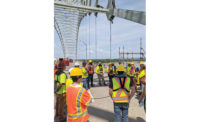"Unbelievable.” That’s how S.T. Wooten Corp.’s heavy highway project manager Matthew Davis characterizes the daily crush of more than 106,000 vehicles along a 13-mile stretch of Interstate 40 outside of Raleigh. And it’s the main reason why his company is in the midst of a four-year, $360-million design-build corridor upgrade that will add two travel lanes in each direction, 15 new and revamped bridges, and two diverging-diamond interchanges.
Davis adds that not even a pandemic-altered economy offered much of a respite for the project, which got underway in fall 2018.
“The traffic eased for a few months last spring, but it quickly came back,” he says.
North Carolina Dept. of Transportation resident engineer Robert Bullock explains that while commuter traffic accounts for much of the routine volume between the I-40/I-440 junction and NC Route 42 in Garner, congestion significantly worsens during spring and summer with the addition of travelers bound to and from the state’s beaches.
And with the corridor’s traffic volumes projected to increase by 65% by 2040, the upgrades had to be implemented as quickly as possible, all without constraining I-40’s existing capacity.
“That made maintaining all lanes of traffic during peak travel a priority from the outset,” Bullock says.
To tackle the project’s complex traffic maintenance and phasing issues, S.T. Wooten and design partner RK&K divided the corridor work into six separate work areas that are being executed west to east.
Davis says the strategy minimizes the potential for disruptions and helps synchronize concurrent activities, from clearing and utility relocations to integrating a new 1,050-ft-long flyover structure at the I-440 interchange to accommodate wider eastbound lanes.
But while carefully sequenced lane shifts allow corridor shoulders and medians to safely accommodate a large share of the widening and bridge reconstruction work, the project team has nevertheless been challenged with finding ways to keep the number of material supply trucks and other construction vehicles from adding to the congestion.
Fortunately, the old real estate adage about the importance of location can sometimes work for construction. In this case, the project’s western section runs near an industrial cluster that includes a quarry and concrete and asphalt plants. Adapting an overpass with temporary fabric ramp structures gives supply trucks direct access to median and shoulder work areas. Davis says the interim access point will support construction activity along more than half of the corridor.
“We have only small windows when we can haul materials on the interstate itself, so the temporary access helps expedite the project and makes things safer for everybody,” he says.
As the widening work makes its way to the corridor’s eastern sections, S.T. Wooten will apply an innovative material transport technique the company used for another Raleigh-area I-40 widening project—a 280-ft long conveyor system across part of the highway linking an adjacent asphalt plant with the median work area. Equipped with heated oil lines to maintain hot-mix temperatures, the conveyor will also channel stone to waiting trucks.
“As with the other measures, it keeps a significant number of construction vehicles out of the travel lanes,” Davis adds.
Innovative interchanges
Not all the project’s challenges are at highway level. A busy conventional interchange at NC Route 42 is being converted into a diverging diamond configuration, with the existing interstate overpass replaced with two 330-ft-long bridges.
While the goal is to provide safer, more efficient traffic movements in the densely developed area, RK&K design manager Brandon McInnis says the close proximity of businesses left little space to incorporate new lane configurations, a sequence that had to be revised to accommodate multiple underground utility relocations.
“That’s why we decided to do two new bridges across the interstate,” McInnis says, adding that along with helping with construction staging, the longer dual structures will also make it easier to incorporate 1.4 miles of new two-lane collector/distributor roads that will serve both the NC 42 exit and nearby Cleveland Road at the project’s western terminus.
“Maintaining all lanes of traffic during peak traffic [was] a priority from the outset.”
—Robert Bullock, Resident Engineer, North Carolina Dept. of Transportation
Although diverging diamond interchanges are relatively new to North Carolina’s road projects, the I-40 corridor will have the distinction of hosting two such structures. Just after the contract for the widening project was let in summer 2018, Amazon announced that it would construct a 680,000-sq-ft distribution center on Jones Sausage Road, which at the time connected with I-40 with a conventional diamond interchange.
Given the anticipated high volume of heavy truck traffic to be generated by the distribution center, NCDOT modified the S.T. Wooten/RK&K widening contract to include an interchange upgrade that had to be expedited in order to coincide with the new facility’s scheduled late 2020 opening.
McInnis says because the existing 350-ft-long interchange bridge was already wide enough to accommodate five travel lanes, the project team could incorporate a diverging diamond configuration with only minor structural modifications, and without the need for additional right-of-way.
“We’re installing a median railing to separate traffic and a new sidewalk/pedestrian railing on one side,” he says. “The interchange is ready-made for Amazon’s trucks and workforce as well as future development in the area.”
Davis says the project team’s ability to quickly integrate the last-minute interchange upgrade into the overall project is a credit to design-build, which has proven its value in many other ways. He cites an opportunity to advance a planned lane shift to the highway’s outer sections so that work on that section’s median could get underway sooner.
“It’s good to be able to get with the engineers and make changes that will benefit the project when plans and the real world don’t match up or someone gets a better idea,” he says.
Weather woes
Design-build has also helped the team find a measure of schedule flexibility to handle unexpected challenges. Rain events have occurred with increased frequency and intensity over the past two years, slowing progress in some parts of the project as areas dry out.
Bullock recalls one rainstorm that caused Swift Creek to rapidly fill its floodplain approximately 20 ft below the project’s new 270-ft-long bridges. Although the structures weren’t threatened with flooding, the event offered a reminder that road and bridge infrastructure needs to be ready for the uncertainties of a changing climate.
“The pavement design raises the interstate by approximately 1 foot, which will help,” he says. “We’re also installing a lot of bores and culverts that will help with drainage and minimize flooding.”
Davis is unsure whether the persistent precipitation interruptions will affect progress toward the project’s scheduled 2022 completion date. Another complicating factor has been slow progress with utility work at the corridor’s eastern end. McInnis cites one seemingly simple gas transmission line relocation that turned into a major shift, requiring new permits and a change in construction sequencing.
“One of the biggest lessons from this project is the need to get as much information from utilities during the proposal process so you can get a better idea of the time needed for that work,” he says,
Bullock adds that while utility issues have been problematic, the December opening of the new I-440 flyover bridge was a major achievement in terms of public perception of project progress. That and the installation of new textured noise walls and other features offer visual proof that a better travel experience is on the way.
“It will definitely be a different corridor when everything gets done,” he says.








